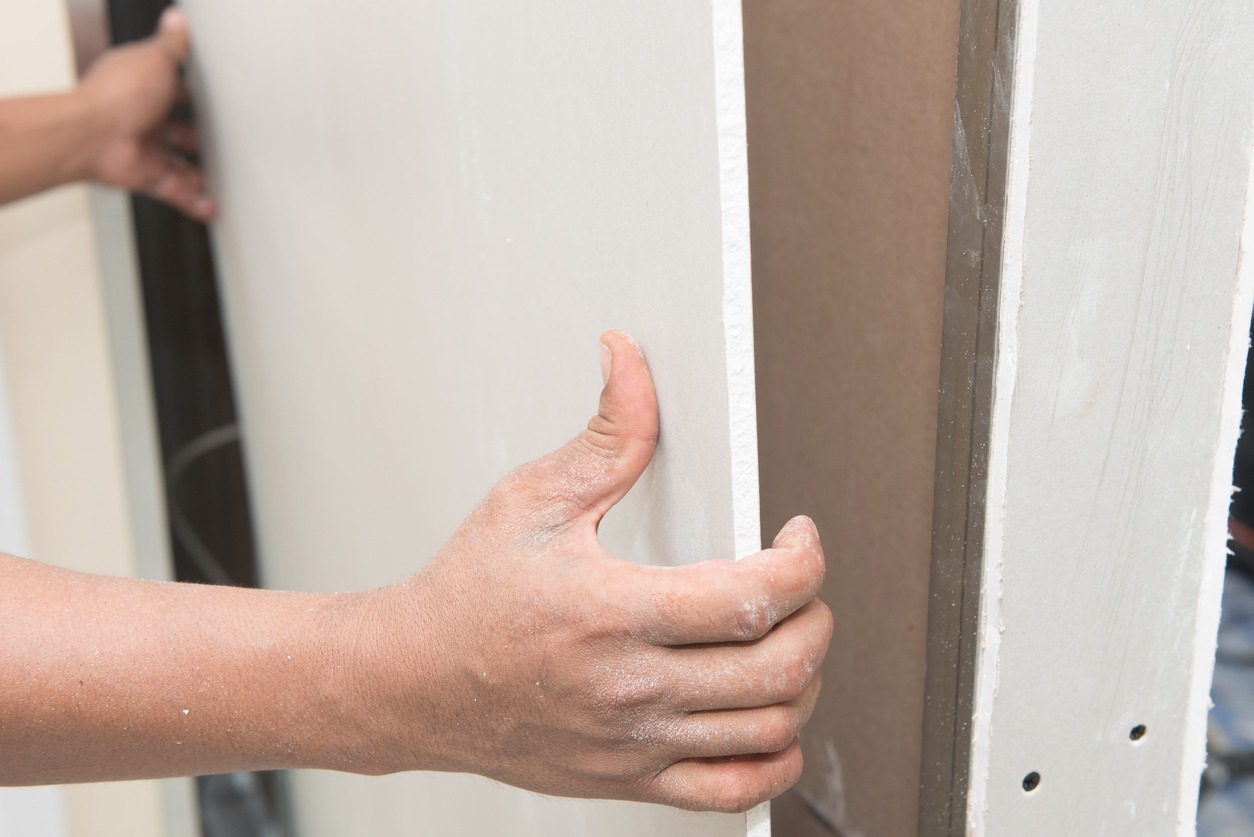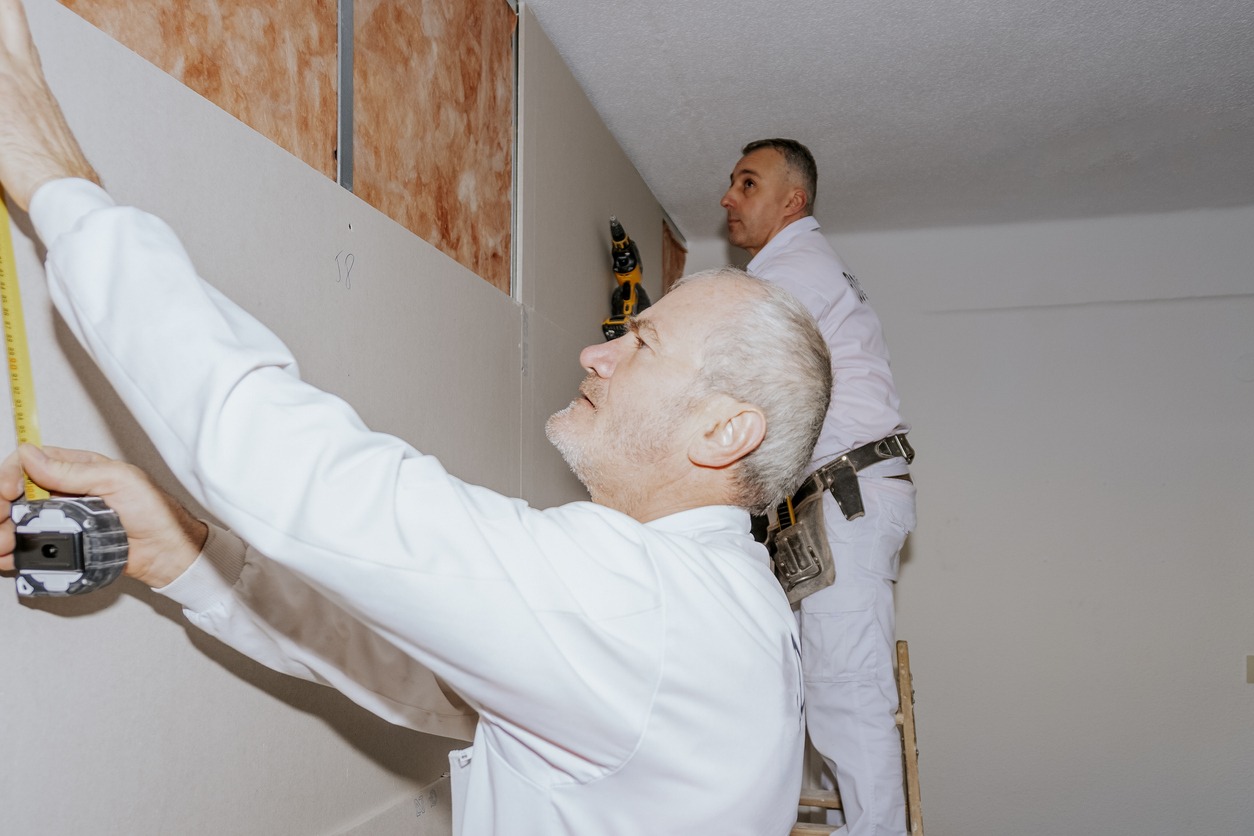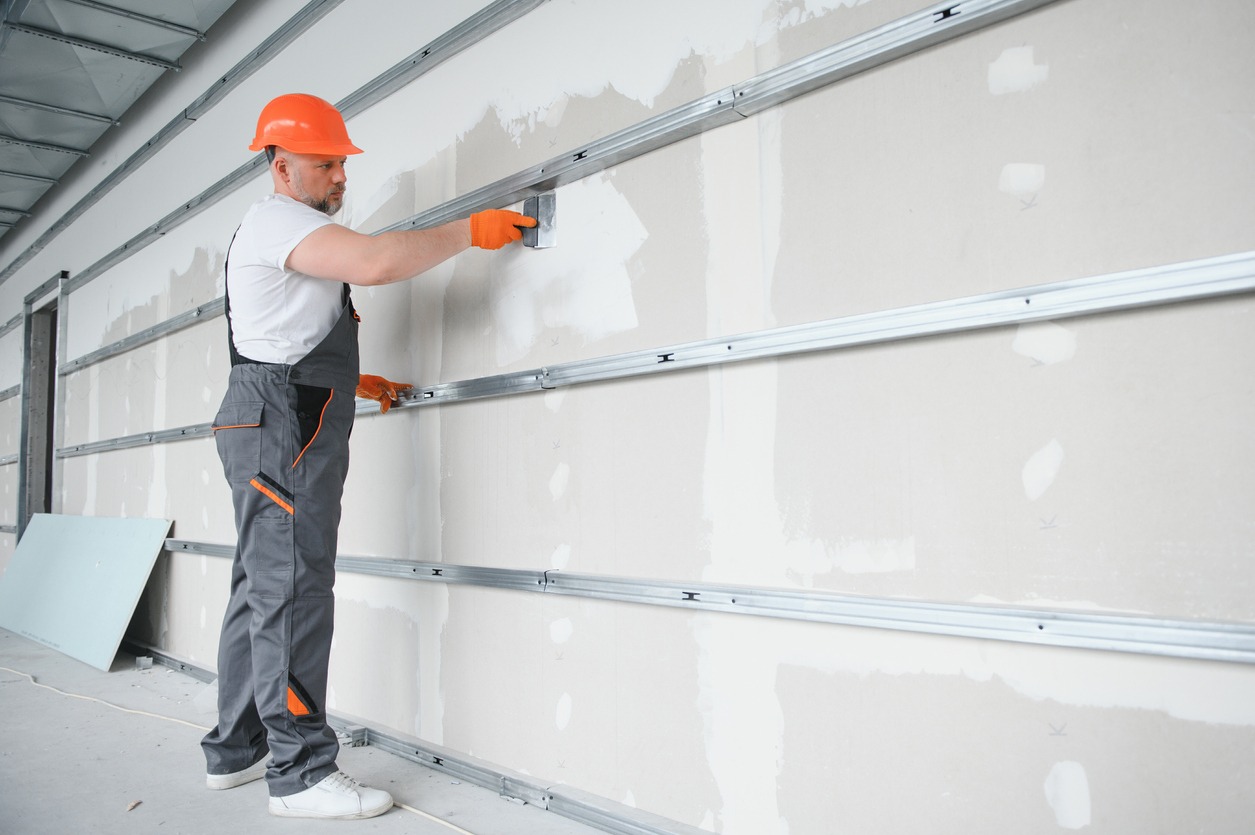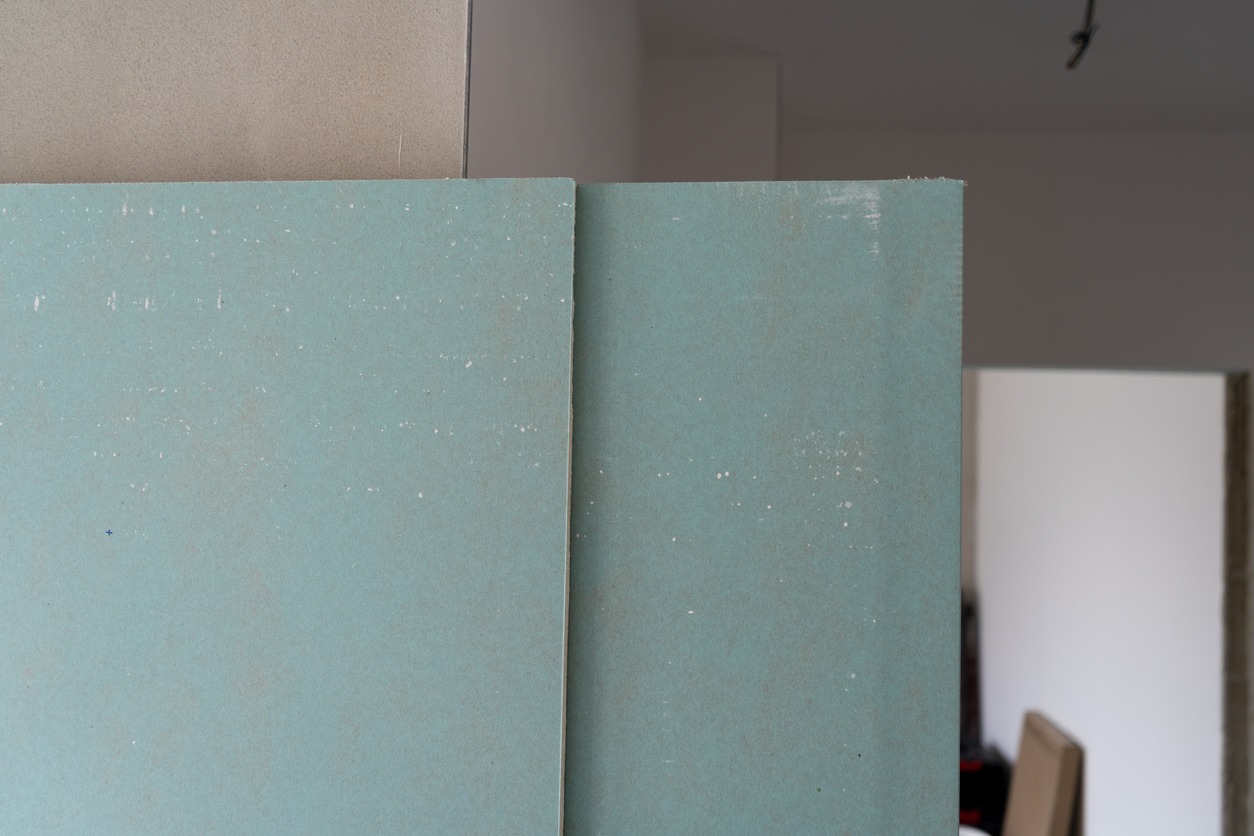Selecting the right drywall for your project is like maneuvering through a maze with various paths, each leading to a different outcome based on your needs. You’re faced with options like regular, moisture-resistant, or even fire-rated drywall, each serving a unique purpose. Whether you’re outfitting a damp bathroom or looking to enhance the fire resistance of a shared wall, there’s a specific type tailored just for your project. However, the decision doesn’t stop at just picking a type; factors such as thickness, installation methods, and overall cost play an important role.
To make an informed choice, you’ll need to weigh these considerations carefully, understanding that the right selection could have a significant impact on the longevity and safety of your space.
Understanding Drywall Basics
Grasping the basics of drywall, you’ll learn it’s a versatile material essential for constructing walls and ceilings in your home. Made primarily of gypsum, a mineral known for its durability, it’s wrapped in paper facing, preparing it for a smooth finish once installed. As you dive deeper, you’ll discover drywall comes in various thicknesses, with 1/2 inch being the most common for interior walls. This diversity guarantees that whatever your project’s needs, there’s a type of drywall that fits perfectly.
Additionally, understanding the different types of drywall is essential for your home’s longevity and comfort. You’ll find options like mold-resistant drywall, ideal for areas prone to moisture where mold could be a concern. This type includes special coatings or additives that help prevent mold growth, providing an extra layer of protection for your walls. As you consider the different types of drywall, remember that each offers unique benefits, such as fire resistance or soundproofing, tailored to specific applications throughout your home. By familiarizing yourself with these options, you’re better equipped to make informed decisions, ensuring your walls are not only sturdy but also provide the necessary protection against common household concerns.
Regular Drywall Explained
You’ll find that regular drywall is the go-to choice for most home construction projects, thanks to its basic yet effective composition. It’s made from a gypsum core pressed between two layers of paper, making it ideal for creating smooth walls in areas like bedrooms and living rooms. Given its standard size of 4×8 feet and a cost-effective price of around $12 per sheet, it’s not hard to see why it’s favored for general living spaces.
Basic Composition
Regular drywall, the backbone of residential construction, primarily comprises a gypsum core encased in two paper layers. This material is the most common type used in homes because it’s versatile, fitting most walls and ceilings perfectly. It’s not just about filling spaces; regular drywall shapes the very essence of your home’s interior. Standard dimensions are 4×8 feet, making it easy to handle and install. Plus, at about $12 per sheet, it’s cost-effective, balancing quality and affordability.
| Feature | Benefit | Emotion |
|---|---|---|
| Gypsum Core | Stability | Security |
| Paper Layers | Smooth Finish | Pride |
| Versatile | Fits Most Spaces | Satisfaction |
Choosing regular drywall means investing in your home’s comfort and aesthetics without breaking the bank.
Common Uses
Having explored the basic composition and cost-effectiveness of regular drywall, let’s now look at where it’s most commonly applied in the home. Regular drywall, with its gypsum core sandwiched between two layers of paper, serves as a versatile and cost-effective option for various interior spaces. Here’s where you’ll find it most useful:
- Bedrooms: For creating peaceful, private areas.
- Living Rooms: Ideal for constructing spacious, inviting environments.
- Basements: Suitable for general wall and ceiling applications in areas with controlled moisture.
- Standard Residential Construction: Its cost-effectiveness and general suitability make it a go-to choice.
Despite its lack of moisture resistance, regular drywall is perfect for areas where dampness isn’t a concern, making it a reliable option for most interior applications.
Moisture-Resistant Drywall
Choosing moisture-resistant drywall, such as greenboard, is essential for areas prone to high humidity or moisture, like bathrooms and kitchens. This specific type of drywall contains additives that greatly enhance its resistance to moisture and mold growth, distinguishing it from regular drywall. If you’re looking to protect your home against water damage, investing in moisture-resistant drywall is a smart move.
Greenboard, with its moisture-fighting capabilities, costs about 20% more than its standard counterpart. However, this extra expense is a small price to pay for the added protection it offers in wet environments. The paper facing on greenboard is specially treated to resist moisture, making it an ideal choice for places in your home that are frequently exposed to water or steam.
Fire-Rated Drywall Types
When considering safety in your home, opting for fire-rated drywall types like Type X is a smart choice, especially in areas prone to fire hazards. Type X Drywall offers enhanced fire resistance, thanks to its unique composition and design features. This specialized drywall has a one-hour fire rating, meaning it can withstand direct exposure to flames for up to an hour before it compromises. It’s particularly suitable for high-risk areas such as garages, where the potential for fire is higher.
Here’s why you should consider Type X Drywall for your home:
- Enhanced Safety: The 5/8 inch thickness and embedded glass fibers provide significant fire protection.
- Meets Building Code Requirements: Installing Type X drywall can help your home meet strict fire safety building code requirements.
- One-Hour Fire Rating: Offers critical time for emergency response, potentially saving lives and property.
- Cost-Effective Protection: Though about 10% more expensive than regular drywall, the fire resistance benefits far outweigh the cost difference.
Soundproofing With Drywall
If you’re aiming to minimize noise in your home, soundproofing with drywall is a smart move. We’ll cover the basics of soundproof drywall, outline the best practices for installation, and help you choose the right materials for your needs. By understanding these key points, you can greatly enhance the quietness and privacy of any room.
Soundproofing Drywall Basics
To effectively reduce noise transmission between rooms, soundproof drywall is crafted from specialized materials including wood fibers, gypsum, and polymers. This unique composition not only minimizes noise but also greatly enhances the soundproofing capabilities of a space. With its laminated layers designed to increase the Sound Transmission Class (STC) rating, soundproof drywall is your go-to choice for areas where acoustics and noise reduction are paramount.
- Specialized Composition: Wood fibers, gypsum, and polymers for superior noise reduction.
- Enhanced Soundproofing: Laminated layers increase the STC rating, reducing sound transfer.
- Ideal Use Cases: Perfect for home theaters, bedrooms, and music studios.
- Cost Consideration: Approximately 400% higher cost than regular drywall, an investment in tranquility and improved acoustics.
Best Soundproofing Practices
Considering the unique composition of soundproof drywall, installing it properly is essential for maximizing its noise-reducing capabilities. Soundproof drywall, crafted with a blend of wood fibers, gypsum, and polymers, greatly reduces noise transmission between rooms. Its advanced composition elevates the Sound Transmission Class (STC) rating, making it a top choice for areas where noise reduction is critical. While it may cost about 400% more than regular drywall, its ability to minimize noise transfer, especially in shared walls or media rooms, is unparalleled. For those yearning for a quiet environment, employing soundproof drywall in bedrooms, home theaters, or offices can transform your space, ensuring peace and tranquility.
Soundproofing Material Choices
When choosing materials for soundproofing, soundproof drywall stands out due to its superior ability to dampen noise transfer between rooms. Its unique composition of laminated layers—including wood fibers, gypsum, and polymers—provides enhanced soundproofing that far exceeds that of regular drywall. Specifically designed to reduce noise transmission, this drywall can greatly increase the Sound Transmission Class (STC) rating of a wall, making it an ideal choice for areas in your home where noise reduction is vital, like home theaters or bedrooms.
- Greatly reduces noise transmission between rooms
- Composed of laminated layers for superior soundproofing
- Increases the Sound Transmission Class (STC) rating of walls
- Ideal for noise-sensitive areas such as home theaters
Eco-Friendly Drywall Options
Exploring eco-friendly drywall options can greatly reduce your project’s environmental footprint. If you’re aiming for a green building, understanding the benefits of these materials is key. Recycled drywall, made from post-consumer waste, not only diverts material from landfills but also provides a high-quality finish. Meanwhile, drywall products using plant-based binders represent a step away from synthetic alternatives, further minimizing chemical use in your home. Additionally, opting for Low-VOC drywall can enhance indoor air quality, ensuring a healthier living environment.
When selecting sustainable choices, consider LEED-certified options. These products meet stringent environmental standards, from production to performance, ensuring your project contributes positively to green building initiatives. Here’s a quick guide to help you understand the impact of your choices:
| Feature | Benefit |
|---|---|
| Recycled Content | Reduces waste, supports recycling efforts |
| Plant-Based Binders | Lowers chemical usage, eco-friendly |
| Low-VOC | Improve indoor air quality |
Drywall for High-Impact Areas
For high-impact areas like garages or playrooms, you’ll want to opt for impact-resistant drywall, designed to endure more force and minimize damage from daily activities. This specialized drywall is a game-changer for spaces that see a lot of action, guaranteeing your walls can take a hit without showing every little mark.
Impact-resistant drywall is your go-to choice for maintaining sleek, dent-free surfaces in the most bustling parts of your home. Here’s why you should consider it:
- Designed to withstand more force: Its reinforced core means it’s tougher than your average drywall, ready to take on whatever comes its way.
- Reduce damage: Less worry about dents and dings means more time enjoying your space, stress-free.
- Ideal for high-traffic spaces: From kids’ play areas to your home gym, it keeps walls looking pristine.
- Long-term investment: Protecting your walls in these high-impact areas can save you money and hassle in repairs down the line.
Choosing impact-resistant drywall for these high-impact areas not only guarantees durability but also maintains the aesthetic and structural integrity of your spaces, making it a smart choice for any busy household.
Navigating Drywall Thickness
Choosing the right drywall thickness is important for your project’s success, as it affects the wall’s durability, soundproofing, and resistance to sagging. Among the common thicknesses, 1/2-inch drywall stands out as the versatile choice, commonly used in most homes for interior walls. This thickness strikes a balance between ease of installation and the structural integrity required for standard residential projects.
However, building codes may dictate the required thickness for specific applications, guaranteeing safety and compliance. For enhanced soundproofing and sag resistance, a thicker 5/8-inch drywall sheet might be necessary, especially in areas where noise reduction is a priority or in ceilings to prevent sagging over time.
Thickness options range from 1/4 inch, ideal for curved walls due to its flexibility, to the more robust 5/8 inch. Each thickness serves a specific purpose, offering varying levels of durability and performance. When selecting the right drywall thickness, it is crucial to take into account the square footage of your project to make sure you purchase enough material, taking into consideration potential waste.
Navigating these options carefully will help you meet building codes and achieve the desired outcomes for your space, whether you’re aiming for durability, soundproofing, or specific aesthetic requirements.
Calculating Your Drywall Needs
After understanding the importance of selecting the right drywall thickness, it’s time to figure out how much you’ll need for your project. The key to a successful drywall project isn’t just in the hanging; it’s in the precise calculation and estimation before a single panel is cut. Here’s how you can get started:
- Calculate the square footage of the area to be covered. This is your starting point.
- Divide the total square footage by the size of the drywall panels. Standard panels are typically 4 feet by 8 feet, but you might consider larger panels for more efficient coverage.
- Add 10% to your total to account for waste and cutting. This guarantees you’re covered for any mistakes or misjudgments.
- Consider using larger panels, like 4 feet by 12 feet, to reduce the number of seams and potentially lessen the waste.
Conclusion
Choosing the right drywall for your project doesn’t have to be a headache. Whether you’re dealing with moisture-prone bathrooms, needing soundproofing for peaceful living, or looking for fire resistance near heat sources, there’s a drywall type for you. Don’t forget about eco-friendly and high-impact options for those special projects. Keep in mind the room’s purpose and the qualities you desire. With a bit of knowledge and planning, you’ll find the perfect drywall to meet your needs.





